To quickly fix seasonal home maintenance problems, start by clearing your gutters of debris to prevent water damage and ice dams. Seal drafty windows and doors with weatherproofing strips or shrink film for instant insulation. Prepare your heating system with filters and inspections to stay warm. Promptly shovel and apply salt to icy walkways for safety. By tackling these tasks efficiently, you’ll protect your home and keep everything running smoothly—more expert tips await as you continue.
Key Takeaways
- Regularly clean gutters and check for clogs to prevent water damage and ice dams before winter.
- Seal drafts around windows and doors promptly to improve energy efficiency and maintain warmth.
- Clear snow and ice promptly from walkways using shovels and salt to ensure safety and prevent property damage.
- Maintain heating systems by inspecting filters, vents, and scheduling professional tune-ups for winter readiness.
- Perform quick lawn and garden cleanup, including mulching and leaf removal, to boost curb appeal and prepare for seasonal changes.
Clearing Clogged Gutters Quickly and Effectively
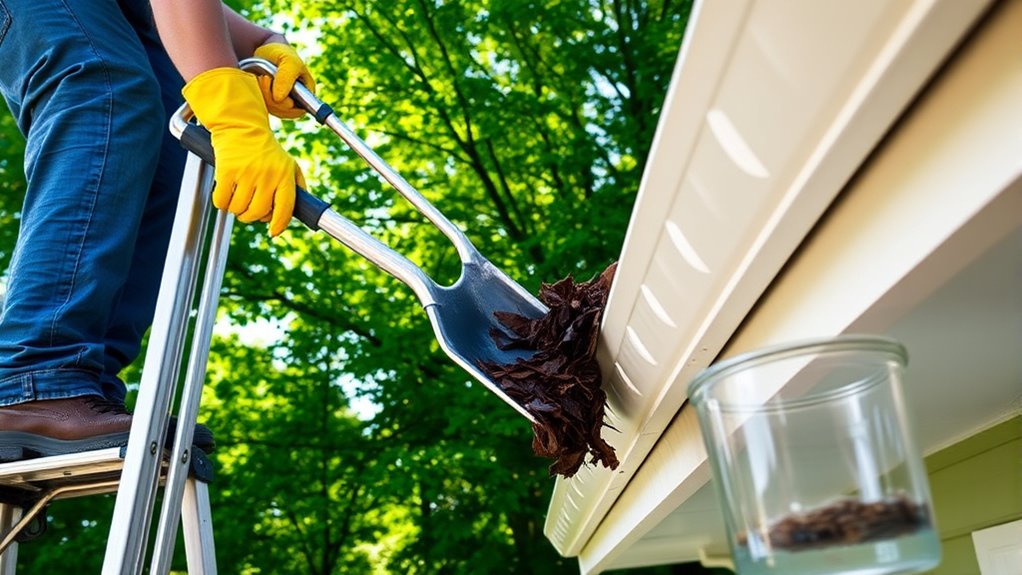
When gutters become clogged, water can overflow and cause damage to your home’s foundation and siding. The main culprits are gutter debris like leaves, twigs, and dirt, which quickly build up and block the flow. To clear this efficiently, start by removing larger debris by hand or with a scoop. Next, use a garden hose to flush out smaller debris and check for downspout clogs. If water doesn’t drain freely, the downspout may be blocked, requiring a snake or a pressure washer. Always wear gloves for safety and work from a sturdy ladder. Regularly cleaning your gutters before heavy rain helps prevent backups and keeps water flowing away from your home, protecting its structure. Being aware of signs of spoilage in gutter debris, such as mold or foul odors, can also help you determine when a thorough cleaning is needed.
Preventing Ice Dams Before They Form
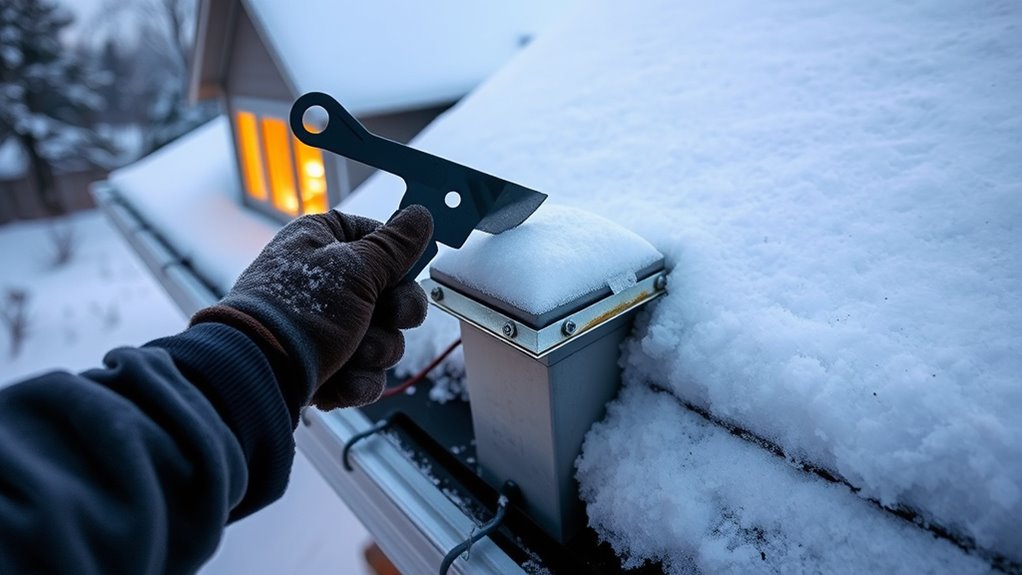
To prevent ice dams from forming on your roof, you need to address the underlying causes before winter arrives. Start by improving your roof insulation to keep heat from escaping into the attic, which melts snow unevenly and leads to dam formation. Adequate insulation ensures that warm air stays contained in your living spaces and doesn’t reach the roof deck. Additionally, ensure proper attic ventilation to help cool the roof and prevent melting snow from refreezing at the eaves. Good ventilation allows cold air to circulate, maintaining a consistent roof temperature. Proper airless paint sprayer maintenance also helps ensure that your home systems function efficiently and do not contribute to uneven heating or moisture issues. Together, effective roof insulation and attic ventilation minimize heat buildup and moisture retention, reducing the risk of ice dams. Taking these steps before winter hits keeps your roof healthier and prevents costly repairs later.
Sealing Drafty Windows and Doors in a Flash

Drafty windows and doors can quickly sap your home’s warmth, but sealing them doesn’t have to take hours. Start by applying simple draft prevention techniques like weatherproofing barriers such as adhesive foam strips or draft stoppers. These low-cost solutions create an instant barrier against cold air. For windows, consider using shrink film kits to add an extra layer of insulation quickly. Doors can be sealed with weatherproofing seals or draft snakes placed at the bottom. Keep in mind, the goal is to block airflow fast, so focus on areas where drafts are most noticeable. Regular inspections and understanding of weather conditions can also help you identify the best spots to seal. With these quick fixes, you’ll improve your home’s energy efficiency and stay warmer without a major overhaul. This simple approach makes seasonal home maintenance both effective and efficient.
Maintaining Heating Systems for Winter Readiness

To get your heating system ready for winter, start by inspecting and cleaning key components like filters and vents. Regular maintenance keeps your system running efficiently and prevents unexpected breakdowns. Don’t forget to schedule a professional tune-up to make certain everything’s working safely and effectively all season long. Additionally, understanding your system’s core traits can help you troubleshoot issues more effectively and optimize performance throughout the season.
Inspect and Clean Components
Before winter arrives, it’s essential to inspect and clean your heating system’s components to guarantee they function efficiently when you need them most. Start by checking your HVAC filters; if they’re dirty or clogged, replace them to improve airflow and indoor air quality. A clean filter ensures your system works effectively and saves energy. Next, perform a chimney inspection if you have a fireplace or wood stove. Remove any creosote buildup, debris, or obstructions that could cause blockages or fires. While you’re at it, inspect vents and registers for dust or blockages. Keeping these components clean prevents system strain and potential hazards, ensuring your home stays warm and safe throughout the winter season. Regular maintenance like this can make a significant difference in your system’s performance. Proper maintenance practices are crucial for preventing unexpected breakdowns and ensuring safety during the cold months.
Schedule Professional Tune-Ups
Scheduling a professional tune-up for your heating system guarantees it runs smoothly all winter long. Regular HVAC maintenance, including a thorough furnace inspection, guarantees your system operates efficiently and safely. During a tune-up, a technician checks for potential issues, cleans essential components, and verifies proper airflow. This proactive approach helps prevent unexpected breakdowns when you need your heater most. A furnace inspection also identifies any worn parts or leaks that could reduce performance or cause safety hazards. Booking this service before the cold weather hits saves you money on energy costs and costly repairs later. Proper system maintenance ensures optimal performance and longevity of your heating unit. Don’t wait until you’re cold—schedule your professional tune-up now to keep your home warm, safe, and comfortable all winter long.
Addressing Lawn and Garden Cleanup in a Hurry
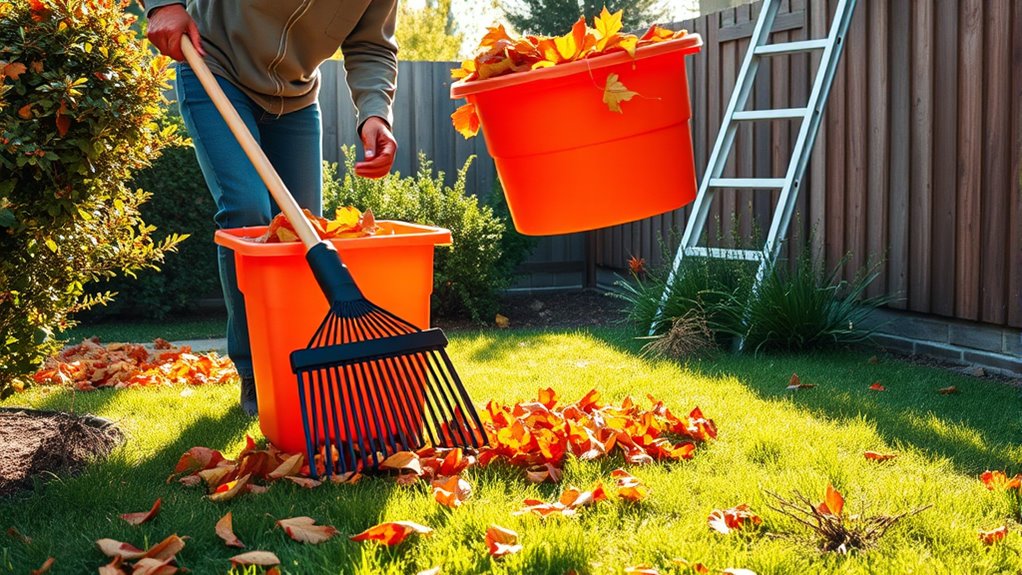
When time is limited, tackling your lawn and garden cleanup quickly becomes essential. Start by focusing on lawn aeration to improve soil health and promote healthy growth. This process helps water, nutrients, and air reach the roots more effectively, giving your lawn a fresh boost. Next, apply garden mulching to quickly tidy up beds and suppress weeds. Mulching also conserves moisture and adds a polished look to your yard. Raking leaves and debris efficiently clears space without getting bogged down in details. Use a leaf blower or quick raking techniques to save time. Prioritize high-impact tasks first, and keep tools organized for swift work. Incorporating self watering plant pots can help maintain your garden’s hydration with less daily effort. With these steps, you can make your lawn and garden look well-maintained, even on a tight schedule.
Protecting Your Home From Winter Storms
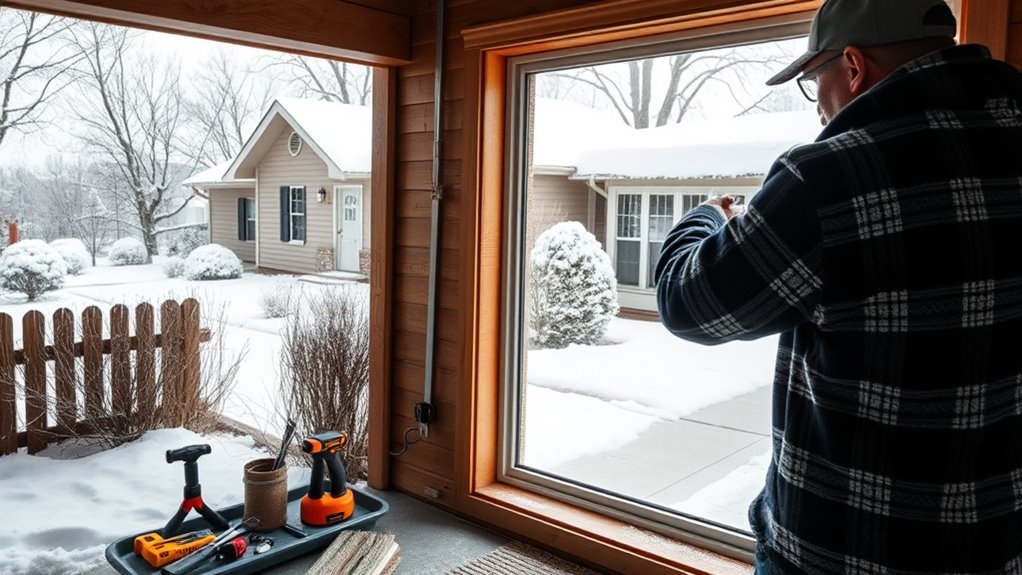
After quickly tidying up your yard, it’s time to shift focus inward to protect your home from winter storms. Start by reviewing your storm preparedness plan, ensuring you have supplies like flashlights, batteries, and emergency kits ready. Inspect your windows and doors for gaps and seal any leaks to improve wind resistance. Reinforce garage doors and shutters to withstand strong winds, and trim any loose or damaged branches that could become projectiles. Clear gutters to prevent ice dams and water damage. Additionally, check your roof’s stability and consider adding extra support if needed. Staying informed about storm damage prevention can help you take proactive measures to safeguard your property. By proactively addressing these areas, you’ll reduce the risk of storm-related damage and keep your home safe during severe winter weather.
Quick Fixes for Snow and Ice Removal
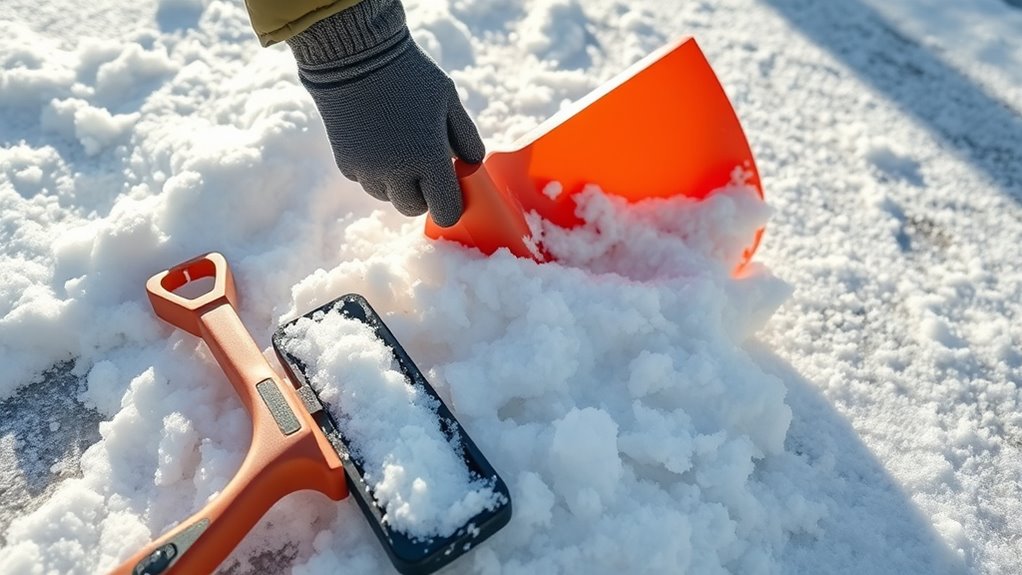
Dealing with snow and ice promptly can prevent accidents and minimize property damage. To de-ice sidewalks effectively, start by using a sturdy snow shovel, applying proper techniques to clear away snow efficiently. Use your shovel at a slight angle and push rather than lift to reduce strain. For icy patches, sprinkle salt or sand to melt ice and improve traction quickly. Avoid using hot water, as it can refreeze and create more hazards. When shoveling, work in small sections to prevent overexertion. Regularly clear snow before it compacts or refreezes, and focus on high-traffic areas like walkways and steps. Additionally, staying informed about weather patterns can help you plan your snow removal efforts better. These quick fixes keep your property safe, prevent slips, and make winter cleanup faster and easier.
Frequently Asked Questions
How Often Should Gutters Be Cleaned During Peak Fall Season?
During peak fall, you should clean your gutters at least every 2-3 weeks to prevent leaf buildup. Regular leaf removal keeps your gutters clear and reduces the risk of clogging and water damage. While cleaning, check for gutter repairs like loose or damaged sections. Promptly addressing gutter repairs guarantees proper drainage and prevents costly issues, especially during heavy leaf fall. Consistent maintenance keeps your home protected throughout the season.
What Materials Are Best for Sealing Drafts Quickly?
Sealing drafts swiftly calls for savvy selections like silicone or latex caulk types, which stick strongly and seal securely. For doors and windows, consider weatherstripping options like foam tape, V-strip, or felt, providing versatile, value-packed coverage. These materials work wonders, warding off wind and cold. You’ll want to match the right caulk type and weatherstripping option to your specific spots to guarantee a snug, sealed, and cozy home all season long.
How Can I Test My Heating System’s Efficiency Before Winter?
You can test your heating system’s efficiency by checking for uneven heating or strange noises, which are signs of HVAC troubleshooting needs. Use a thermometer to measure room temperatures and compare them to your thermostat settings. Confirm vents are open and unobstructed. For better energy efficiency tips, schedule a professional inspection before winter, change filters regularly, and consider a duct sealing to optimize your system’s performance.
What Are Quick Ways to Prevent Ice Buildup on Walkways?
Did you know that slips on icy walkways cause over 17,000 injuries annually? To prevent ice buildup, use effective ice melt options like calcium chloride or magnesium chloride, which work faster and last longer. Consider installing walkway heating mats for a quick, hands-free solution. These options keep your paths safe and clear, reducing the risk of falls and making winter maintenance much easier and safer for you.
How Do I Safely Remove Snow From Roofs Without Damage?
To safely remove snow from roofs, start by using a roof rake with a long handle to avoid climbing ladders. Clear snow gradually, working from the edge inward, and avoid sharp tools that can damage shingles. Make sure to remove snow evenly to prevent ice dams. Always prioritize safety by using proper gear and, if unsure, hire professional roof snow removal services for safe snow clearing.
Conclusion
With these quick fixes, you’re the captain steering your home through seasonal storms. Think of each task as a shield, guarding your castle against nature’s surprises. When you act swiftly, you’re not just fixing problems—you’re weaving a safety net that catches any trouble before it takes hold. Stay proactive, and your home will stand strong, like a fortress rooted in resilience, ready to face whatever winter throws your way.









